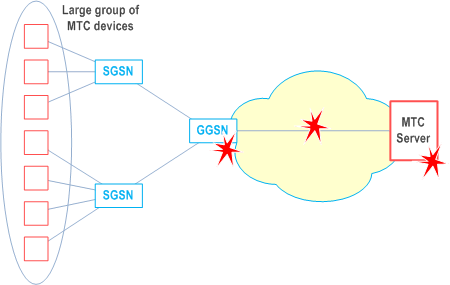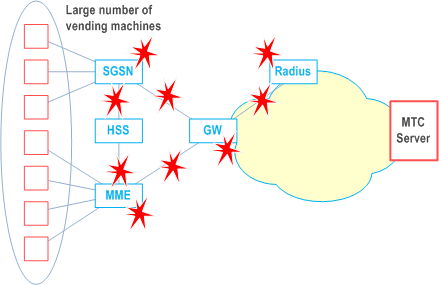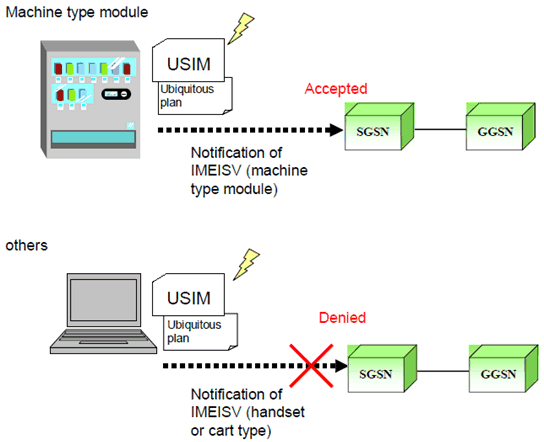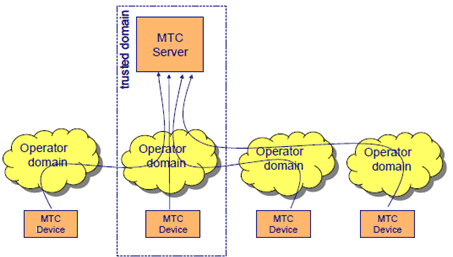Content for TS 22.368 Word version: 18.0.1
A Use cases p. 19
Addressing from a centralized entity Use Case
Metering devices are typically monitored and controlled by a centralized entity outside or inside the network operator system. Due to the need for centralized control, the centralized entity will inform or poll the metering device when it needs measurement information rather than the metering device autonomously sending measurements. Depending on the nature of the metering application, low latency responses are sometimes required (metering for high pressure pipelines for example). To accomplish this, the centralized entity will need to inform the metering device when it needs a measurement. Typically due to the limitation of IPv4 address space, the metering terminal is behind a NAT (Network Address Translator) where it is not assigned a routable IPv4 address.
Theft /Vandalism Vulnerable MTC Application Use Case
In contrast to the traditional H2H devices, which are carefully held and protected by a person, MTC Devices are often located in remote areas and ideally are untouched after installation for many years. The remote locations make these devices more susceptible to tampering by unauthorized persons. The tampering of the MTC Device is often accompanied by damage to the metering device. The network has security mechanisms for protection for this type of activity which may not be effective for MTC Devices. The network can not prevent it but can detect it as early as possible in order to deactivate the ME's service and the related USIM. In addition, often theft/vandalism vulnerable MTC Devices are stationary after initial installation and activation. The stationality of the MTC Device can be utilized to improve the detection of theft. If a known stationary devices moves, it can be concluded that the MTC Device has been stolen and thus the account deactivated.
Time Controlled MTC Application Use Case
For some MTC applications the actual time at which communication takes place is less important, but low communication costs are extremely important. A network operator can offer low communication fees for this type of applications by allowing communication to take place during low traffic time periods only. Possibly the network operator may want to dynamically adjust these time periods based on the actual network traffic load at a specific time.
Radio Network Congestion Use Case
Radio network congestion because of mass concurrent data transmission takes place in some MTC applications. One of the typical applications is the bridge monitoring with a mass of sensors. When a train passes through the bridge, all the sensors transmit the monitoring data almost simultaneously. The same thing happens in hydrology monitoring during the time of heavy rain and in building monitoring when intruders break in. The network should be optimized to enable a mass of MTC Devices in a particular area to transmit data almost simultaneously.
Core Network Congestion Use Case
With many MTC applications, a large number of MTC Devices is affiliated with a single MTC User. These MTC Devices together are part of a MTC Group. The MTC User associated with the MTC Group owns a MTC Server which is connected to the PS network of a mobile network operator via an Access Point Name (APN) using the Gi interface. The MTC Devices in the MTC Group communicate with this MTC Server.
Typically, the MTC Devices in the MTC Group are scattered over the network in such a way that the data simultaneously sent by the MTC Devices in any particular cell is limited and will not cause a radio network overload. Despite this, when a high number of MTC Devices are sending/receiving data simultaneously, data congestion may occur in the mobile core network or on the link between mobile core network and MTC Server where the data traffic related to MTC Group is aggregated. Preferably, a network operator and the MTC User have means to enforce a maximum rate for the data sent/received by the MTC Group.

Signalling Network Congestion Use Case
Congestion in the signalling network is caused by a high number of MTC Devices trying almost simultaneously: (1) to attach to the network or (2) to activate/modify/deactivate a connection. In a 3GPP system supporting MTC applications such an overload of the network can be caused by e.g. many mobile payment terminals that become active on a national holiday or by high numbers of metering devices becoming active almost simultaneously after a period of power outage. Also some MTC applications generate recurring data transmissions at precisely synchronous time intervals (e.g. precisely every hour or half hour). Preferably, the 3GPP system provides means to the network operator and MTC User to spread the resulting peaks in the signalling traffic.

Access Control with billing plan Use Case
In some configurations, it may be necessary to restrict the access of a UICC that is dedicated to be used only with machine-type modules associated with a specific billing plan. It should be possible to associate a list of UICC to a list of terminal identity such as IMEISV so that if the UICC is used in an other terminal type, the access will be refused.
See the following configuration:

Extra Low Power Consumption Use Case
For high mobility case, tracking MTC devices such as animal tracking MTC devices in natural world with high mobility require extra low power consumption because it is almost impossible to replace the battery or recharge the battery for animal tracking MTC device. Compared to the tracking devices installed in the cars and trucks because cars and trucks could generate electricity by themselves, extra low power consumption for these MTC devices is required.
For cargo tracking, the cargo with a tracking MTC device could move very fast such as on a train or lorry and could stand still such as in the dock before loading or unloading. It is not desired to either change its battery or replace battery during the transport period, so extra low power consumption MTC devices are also required.
For prisoner tracking MTC devices are already used by police, prisoners will not cooperate with police and would wish the MTC devices have flat batteries; therefore, extra low power consumption feature is required for these MTC devices. For the tracking MTC devices of elder people who have memory problem, children or pets, even the batteries of these MTC devices could be replaced or charged, however, considering the worst scenario - if they are missing, it requires the MTC devices with extra low power consumption and long working time in order to find them.
For low mobility case, the gas meter MTC devices must be battery powered. Extra low power consumption for gas MTC devices is much more critical than electricity meters.
Extra Low Power Consumption with Time Controlled MTC Devices Use Case
Time Controlled MTC Devices which send or receive data only at certain pre-defined periods may be operated in one or more modes that minimize power consumption.
An MTC Device may be operated in a mode where it is expected to receive non-periodic messages (e.g. emergency messages or notifications of altered access period as with the MTC Feature Time Controlled outside the time controlled periods. The MTC Device should minimize power consumption while in a mode to support this.
If the application requires the MTC Device to send or receive data within pre-defined periods and receive non-periodic messages outside these periods, operation at the lowest possible power consumption level to extend battery life should be achieved.
End-to-end security for roaming MTC devices
An MTC Application communicates with a large number of MTC Devices that are located globally and may or may not be mobile. Examples of such devices are mobile navigation systems and payment terminals. Connectivity for the MTC Devices is provided by a single network operator that uses its roaming agreements to connect MTC Devices that are not within range of its own network.
From the perspective of the operator of the MTC application its MTC Server and the domain of its network operator are part of a trusted domain. However, the domain of the roaming operator are not seen as part of the trusted domain, as is depicted in the Figure below.

The operator of the MTC application therefore requires end-to-end security for messages exchanged between MTC application and MTC Devices. The network operator does not have control over the security features in the domain of the roaming operators. Furthermore, for efficiency reasons the roaming operators may decide on a local breakout to for instance the Internet for MTC traffic in which case the information partly travels over the Internet. The network operator needs to satisfy the MTC application owner's end-to-end security requirement without relying on network security alone.
B Examples of MTC applications p. 23
Some examples of machine-type communication applications are listed in the following Table. This list is not exhaustive and is intended to be indicative of the scope of machine-type communication applications.
| Service Area | MTC applications |
|---|---|
| Security | Surveillance systems
Backup for landline Control of physical access (e.g. to buildings) Car/driver security |
| Tracking & Tracing | Fleet Management
Order Management Pay as you drive Asset Tracking Navigation Traffic information Road tolling Road traffic optimization/steering |
| Payment | Point of sales
Vending machines Gaming machines |
| Health | Monitoring vital signs
Supporting the aged or handicapped Web Access Telemedicine points Remote diagnostics |
| Remote Maintenance/Control | Sensors
Lighting Pumps Valves Elevator control Vending machine control Vehicle diagnostics |
| Metering | Power
Gas Water Heating Grid control Industrial metering |
| Consumer Devices | Digital photo frame
Digital camera eBook |